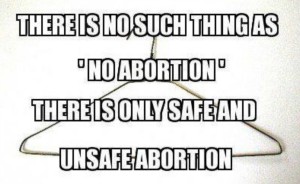I returned to our room in the cheap hotel in Paris to find a bloody mess. My roommate, John, left a note that he had gone to the hospital with his girlfriend.
We were in college and were spending the summer studying the French language. John had met Ruth in London, our first stop. She was already pregnant and had decided, although it wasn’t legal, to abort the pregnancy. She arrived in Paris several days later and thought that everything had gone well. Immediately after she got to our room she started to hemorrhage. John called an ambulance, she was hospitalized, transfused and had a D&C. She recovered eventually.
That was my first introduction, as an innocent 20 year-old, to the subject of abortion, and my first brush with gynecology. It made a lasting impression.
Two years later my fiancée (and later, wife) was in graduate school and I in medical school in a different city. One of Gail’s roommates had been out of town, then spent a night in the hospital. After she returned to the apartment the police came for an official and frightening visit. The hospital reported that Jane had had an abortion and the visit was to find the identity of the doctor who had performed it. The officials interrogated her at length but left without that information.
Fast forward to when I was in general practice in New Mexico. The records of a new patient showed that she had had a hysterectomy—not unusual for a middle-aged woman. But what was surprising was the pathology report. In addition to the expected uterus, it showed a 6-inch long splinter of wood! I asked the woman how the splinter got there. She replied that she didn’t know, that she was as mystified as me. We both knew what the real story was.
During my residency I was called to the emergency room one evening to see a woman who was pregnant and bleeding. This was her 4th pregnancy; she had 3 young children at home. I thought she could be having a miscarriage. Spotting could also be an indication that the woman was trying to cause an abortion by introducing something into her uterus. Abortion was already legal in all states in the USA, although the Supreme Court decision was less than a year old.
Back then I used to warn all women with a threatened miscarriage that it was important to tell me if they had done anything to abort the pregnancy. This was because nonmedical abortions were still common, and because of the risk of a serious infection. This woman responded “noâ€, she would never do that—she was a member of a religion that didn’t believe in abortion.
I was surprised a few hours later when the same woman returned to the ER. She told me that she returned because what I had told her worried her. She couldn’t be sick because her children needed her. She admitted that she had, indeed, tried to cause an abortion with a knitting needle.
These are cases that I can remember well of women who faced unwanted pregnancies. All of these cases are long past history, thank goodness, because now safe abortion services are available. Regrettably some people are trying to take away access to safe, empathetic and legal abortion. Worldwide over 20 million women have unsafe abortions, resulting in 50,000 maternal deaths and many more serious injuries. “Not Yet Rain†is a video made in Ethiopia about the difficulty young women have in getting safe abortions after rape. Studies show that abortion is actually more common where it is illegal!
An unplanned, unwanted pregnancy is a difficult situation for a woman to face. Sometimes things work out well and the child is adopted. Sometimes the child is raised by the mother and loved despite an inauspicious beginning. But often things don’t work out well. Currently women in the USA occasionally resort to unsafe abortions because of increased difficulty in accessing safe abortion services.
Some politicians are trying to overthrow the Supreme Court’s Roe v. Wade ruling. They put hurdles in the way of women to decrease access to abortions. They also decrease access to contraception, the best way to decrease the need for abortion, by defunding Planned Parenthood. They advocate needless requirements for clinics that have provided safe abortion services for years without them. For women’s sake and for the sake of our already overcrowded planet we must maintain access to safe, legal abortion services.
© Richard Grossman MD, 2016
Category: Reproductive Health
A recent Durango Herald article detailed the “New Year’s resolutions†of three Southwest Colorado lawmakers. There is an important issue that was not mentioned in this article, and Rep. Coram may have part of its solution.
Let me start by trying to summarize what is on each of the legislators has said. State Senator Ellen Roberts is focusing on rural healthcare costs—for good reason! Although we in the USA spend the most per capita of any country in the world, our health statistics lag behind many other countries. Senator Roberts is also concerned about problems brought up by the Gold King Mine spill. I am confident that her excellent legal mind can help pass a “good Samaritan†law for mine mitigation, and decrease barriers between states in dealing with emergencies. Finally, she is concerned about the monstrous wildfires we have experienced recently.
J. Paul Brown, our Representative in the Colorado House, rightly picks transportation and water as key issues for the legislative session that has just begun. He and I probably disagree about transportation because I support public transportation as well as highway improvement. But we definitely agree about water! J. Paul’s website states: “Water is the most precious resource on Colorado’s West Slope…. As your State Legislator, I will work tirelessly to protect our water.†Globally, water is the most precious resource.
Don Coram represents people a bit to the north and west of La Plata County, nevertheless he was included in this article. The only issue mentioned is voter registration, but I admire him for another topic. In 2015 he was one of the sponsors of a bill to provide safe, effective contraception to low-income women. A Republican, the bill had a Democratic cosponsor. Unfortunately, the bill failed. Fortunately, however, a coalition of private donors has temporarily picked up part of the slack.
You probably recall that a foundation funded provision of Long Acting, Reversible Contraceptives (LARCs) here in Colorado. LARCs consist of IUDs and a hormonal implant, all of which are safe and appreciated by women, but are usually out of the price range of those who don’t have insurance. They are much more effective than over-the-counter methods such as condoms, and are even 20 times as successful at preventing pregnancy as “the pillâ€. That grant was for a 5-year period which ended in 2015. This funding had a remarkable effect! There were fewer abortions in Colorado, and our teen pregnancy rate dropped by 40%.
Despite Representative Coram’s best efforts, the legislature would not approve funding to continue the program. The reason given for disapproval by other legislators was that IUDs sometimes cause abortions. The best medical knowledge is that IUDs do not cause abortions—but it is well known that unplanned pregnancies often end up being aborted.
Public health sources state that each dollar spent on family planning saves from 4 to 7 healthcare dollars. This is a better return on investment than just about anything else! Personal benefits, such as allowing a young woman to finish college are of even greater value. Other advantages, however, go beyond the obvious. The cost of insurance is lower if there are fewer unplanned pregnancies, Senator Roberts. Some of the highest healthcare costs are those associated with premature birth. The pregnancies that LARCs prevented in this study would have likely been to the women most likely to give birth prematurely—young and poor.
What is causing those terrible wildfires that we are having trouble paying for? Climate change is a major factor. What is the least expensive way to slow greenhouse gas emissions? You guessed it—family planning! Fewer people mean fewer emissions. LARCs won’t provide a short-term solution for either climate change or wildfires, but they can help in the long term.
Representative Brown, please remember that the more people who drive on our highways, the more costly they are to maintain. Likewise, the more people there are in Colorado, the greater the need for water. Most of the growth is on our state’s Eastern Slope. As its population increases, the pressure for them to get our Western Slope water will increase. Again, LARCs won’t solve transportation or water problems right away, but funding them can reduce the size of the problems that our children and grandchildren have to deal with.
Thank you for your courageous stand, Representative Coram. I am sorry that I cannot vote for you, but hope that you will find new allies in support of another bill to pay for LARCs.
© Richard Grossman MD, 2016

